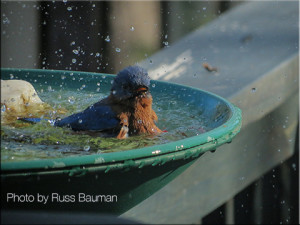Once, long ago, the Eastern Bluebird was one of North Carolina’s most common songbirds. Man’s activities, several severe winters, and other factors resulted in our bluebird population declining by as much as 90%. The bluebird has made a strong comeback, due largely to conservation efforts. However, the continuing loss of natural nesting sites and other problems faced by bluebirds indicate that this beloved bird will always need man’s help to survive.

Reasons for Bluebird Decline
Habitat Loss
- Nesting sites were lost when wooden fence posts were replaced with metal posts and dead trees and limbs were cut for firewood and to make wooded areas more attractive.
- Many small farms have been combined into large operations with huge fields that destroy the mixed habitat needed by bluebirds.
- Cities have spread into rural areas further reducing bluebirds’ preferred habitat.
Limited Food Supply
- Birds eat constantly during the day in order to survive cold winter nights. When their food is covered by heavy snow or ice, thousands of birds die.
- The winter food supply has also been reduced greatly by civilization’s spread.
- The European Starlings strip the fruit from the trees early in the fall, taking a valuable food resource from bluebirds.
Harmful Chemicals
- DDT killed the
insects bluebirds fed on and even killed the birds themselves.
Non-Native Birds
- In the
1800’s man brought the European Starling and House (English) Sparrow (whichis really a European weaver finch) to this country from Europeupsetting our balance of nature forever. These birds are so adaptableand aggressive that they spread across the continent taking nesting sites and even killing the native birds and destroying their eggs.

